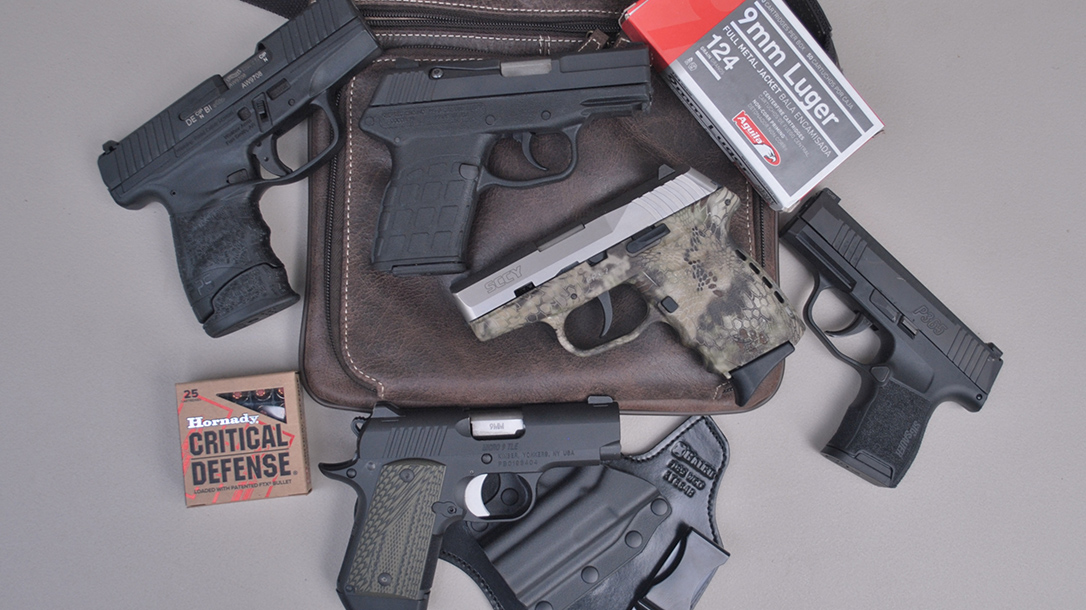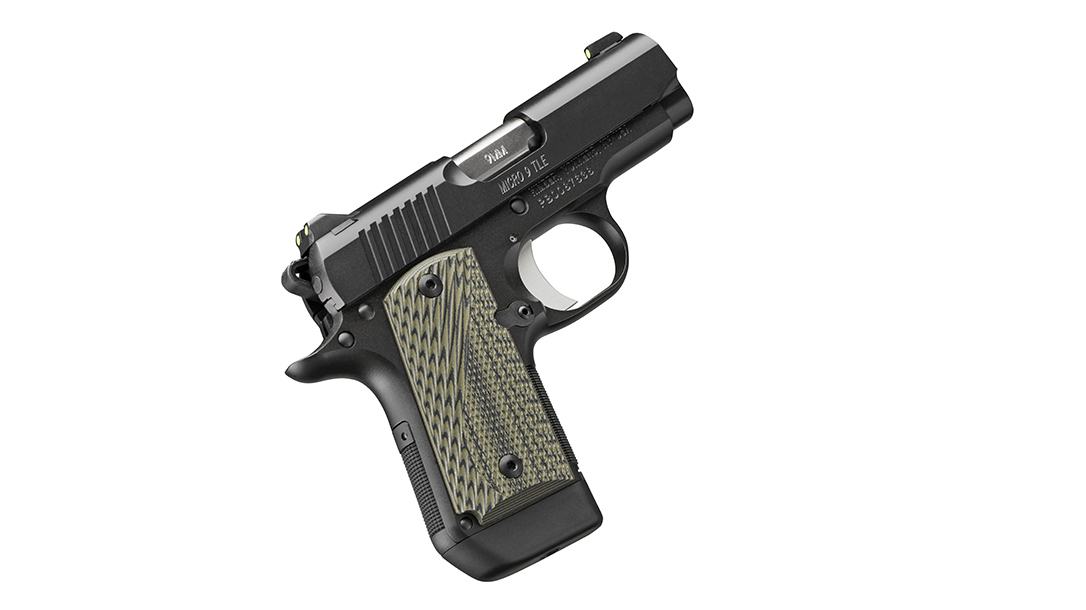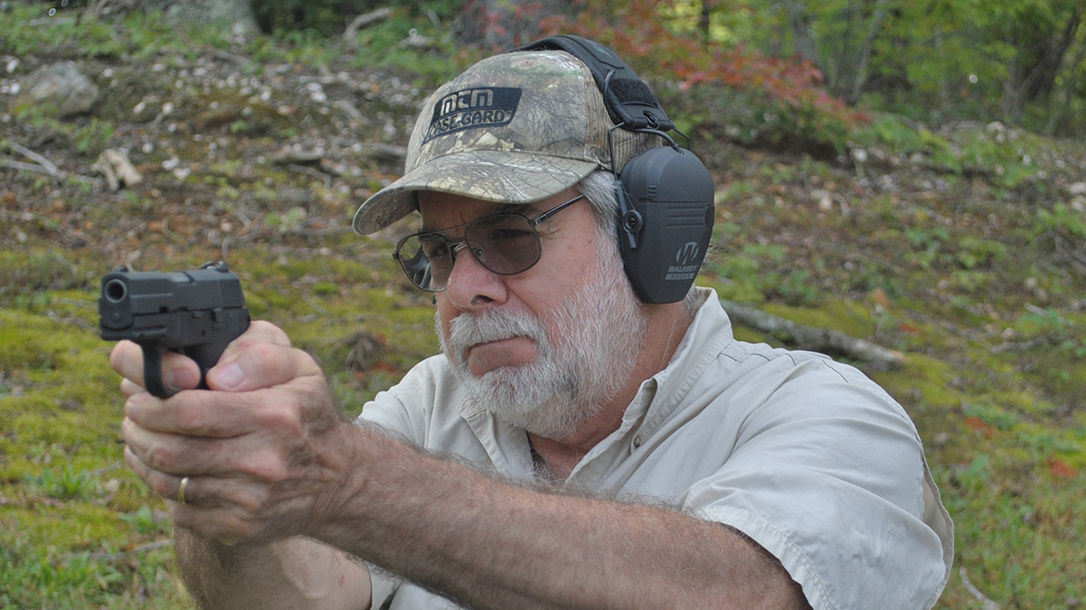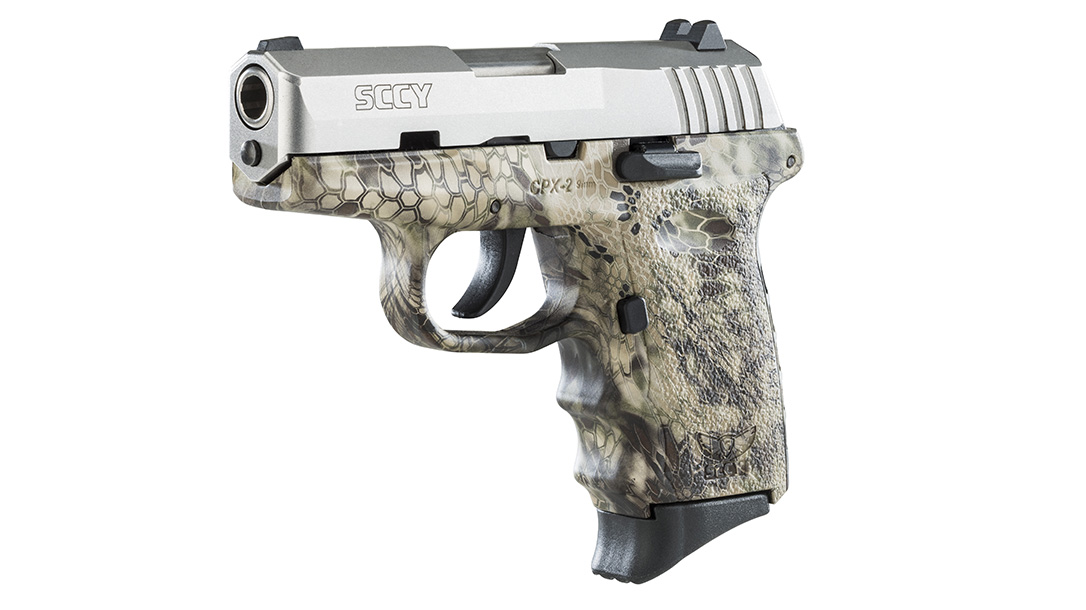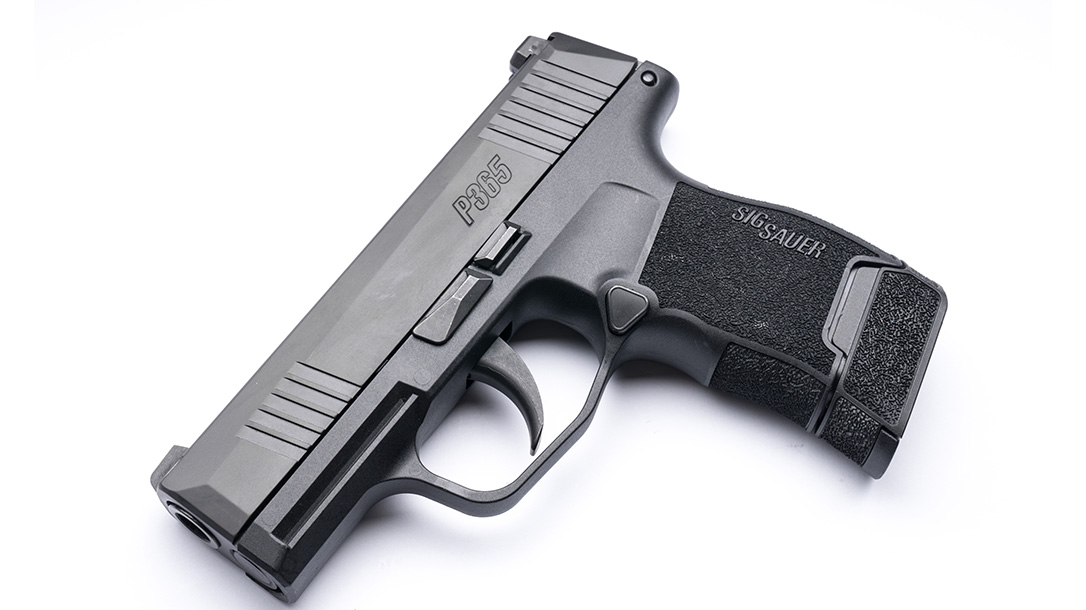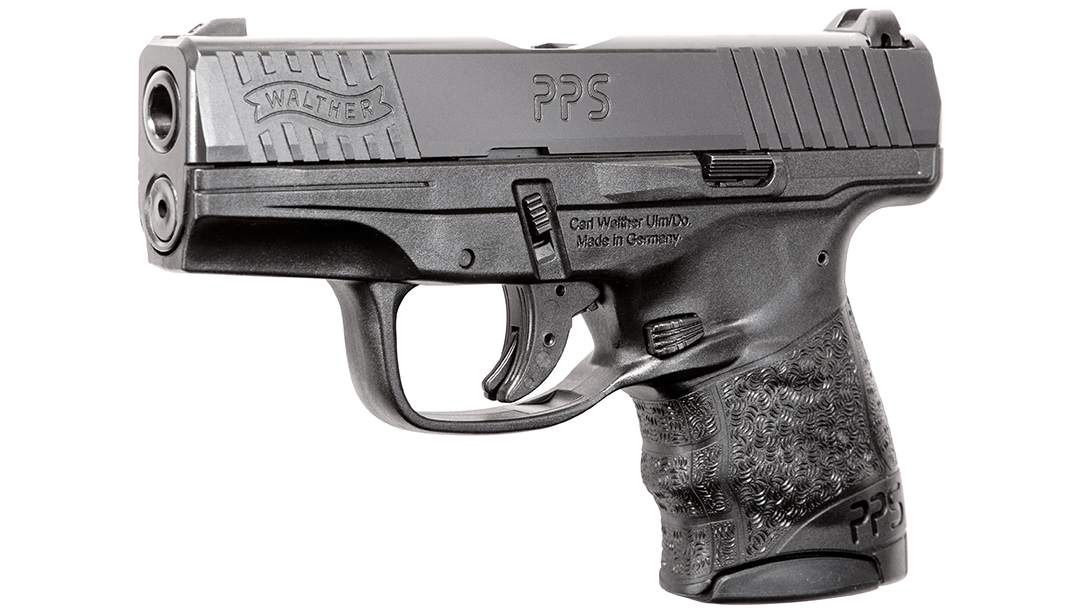In the last decade, there has been a tremendous rebirth of interest in Georg Luger’s legendary 9mm cartridge among law enforcement agencies, competitive shooters and civilians who own handguns for defensive purposes. There are several reasons for this renewed popularity.
Thanks to improvements in propellants and high-tech expanding projectiles, the performance of the 9mm now equals that of larger-caliber cartridges. And even with +P and +P+ loads, the 9mm generates less recoil than .40 S&W and .45 ACP cartridges, which allows for easier training and faster, more accurate shooting. Finally, the 9mm’s smaller size makes it a practical choice for full-power compact and subcompact pistols. Which brings us to this issue’s “Battle Royale,” where we’ll look at five of the newest subcompact 9mm pistols: the Kimber Micro 9 TLE, the KelTec PF-9, the SCCY CPX-2, the SIG Sauer P365 and the Walther PPS M2.
Advertisement — Continue Reading Below
Subcompact 9mm Contenders
When it comes to construction, the KelTec, SCCY, SIG and Walther all use aluminum or steel rails encased in polymer frames. These metal rails secure internal parts like the sear, trigger and hammer housings, add strength and provide the interface for the steel slide to reciprocate on. The Kimber is the odd man out in having a 1911-style aluminum alloy frame with integral rails, and the frontstrap is checkered — a very nice touch.
The actions also vary. The KelTec and SCCY use internal hammers and double-action-only (DOA) triggers, while the SIG and Walther are both striker-fired. And, once again, the Kimber follows the beat of a different drummer with a traditional single-action (SA) trigger.
While all five subcompact 9mm pistols include various internal safety devices, the Kimber has a frame-mounted thumb safety, as befits a mini 1911. Along with having a striker status indicator that protrudes from the rear of the slide, the Walther also has a safety paddle built into the face of its trigger. The KelTec, SCCY and SIG all depend their triggers as safety devices.
Advertisement — Continue Reading Below
All five feature three-dot sighting arrangements. The KelTec has plain white-dot sights; the Kimber, SCCY and Walther have tritium night sights; and the Sig’s XRAY3 front sight has a tritium insert surrounded by a highly visible green right that makes it equally visible in low- and bright-light conditions, and the rear sight has two tritium inserts. Finally, the magazine capacities vary from six to 10 rounds.
Range Rules
Before venturing forth to run the mandatory off-hand drills with this quintet of demure 9mms, my wife, Becky, and I checked each pistol’s zero by firing five groups from an MTM K-Zone rest at a moderate 10 yards. All five guns shot to the point of aim and produced groups ranging from 1.4 to 2.3 inches in size, which we considered perfectly adequate for pistols designed for close-range self defense.
Afterwards, we cleaned and lubed each pistol — the only maintenance they received. If one malfunctioned, we would attempt to correct the problem at the range. If we were unable to do so, the offending pistol would be scored up to that point and then put aside while we finished testing the remaining guns.
Advertisement — Continue Reading Below
My good friends Richard Cole and Dick Jones once again volunteered to assist Becky and I in testing our quintet of subcompact 9mm pistols. After discussing various ways of judging a pistol’s handling characteristics and ability to engage multiple targets quickly, we decided upon the following three drills.
Steel Plate Drill
From 8 yards, the shooter engages a rack of five 8-inch steel plates. The score consists of the total time for four runs plus a five-second penalty for any plate left standing.
| Dick | Paul | Richard | |
| Kimber | 4.6 | 7.0 | 7.0 |
| KelTec | 8.3 | 7.2 | 14.5 |
| SCCY | 5.6 | 5.3 | 9.0 |
| SIG Sauer | 6.0 | 4.5 | 7.3 |
| Walther | 5.2 | 5.9 | 7.6 |
Zombie Drill
Inspired by The Walking Dead, this drill has the shooter facing three IPSC targets set 5 yards from the firing line. On the signal, they double-tap each target in the body, but realizing that zombies can only be killed by a headshot, they perform a combat reload and reengage each target accordingly. Again, the score consists of the total time for four runs plus five-second penalties for misses.
Advertisement — Continue Reading Below
| Dick | Paul | Richard | |
| Kimber | 11.6 | 14.3 | 14.8 |
| KelTec | 12.4 | 14.5 | 17.1 |
| SCCY | 11.5 | 12.2 | 14.4 |
| SIG Sauer | 11.1 | 14.5 | 13.3 |
| Walther | 13.5 | 11.2 | 12.2 |
One-Handed Drill
The shooter draws and fires seven rounds at one of three IPSC targets 3 yards from the firing line, firing every round with a one-handed grip. They then perform a combat reload and engage the two remaining targets in the same manner. The scoring is the same as the previous drills.
| Dick | Paul | Richard | |
| Kimber | 18.4 | 21.0 | 27.8 |
| KelTec | 16.5 | 21.3 | 22.8 |
| SCCY | 15.9 | 18.4 | 19.3 |
| SIG Sauer | 17.0 | 24.0 | 20.8 |
| Walther | 14.3 | 21.5 | 19.3 |
In the end, these three drills required that each of us fired a minimum of 81 rounds through each pistol for a total of 405 from the five of them. Our test ammo consisted of 124-grain FMJs from Aguila and 115-grain Critical Defense rounds from Hornady. To level the playing field, every drill began with pistols loaded with eight rounds and the shooter holding the gun in the low-ready position. Competition Electronics provided us with a Pocket Pro shot timer, and the Target Barn once again provided IPSC cardboard targets.
Then Richard, Dick and I would grade each pistol from 1 (worst) to 5 (best) in seven different categories, including reliability, ergonomics, trigger control, recoil control, sights, off-hand accuracy and reloading ease. These were then added together to give each pistol a final score out of 15 in each category.
Advertisement — Continue Reading Below
In-Depth Results
Reliability
We experienced a total of seven malfunctions, all failures to feed with both types of ammunition: Three with the Walther, two with the KelTec and one with the SCCY. The shooters were able to clear them all quickly and continue sending rounds downrange. Considering these were all new pistols, we felt that the problems would disappear with use.
Ergonomics
The SCCY, SIG and Walther all tied for 14 points in this category, mostly due to their well-shaped grip frames. Their controls were also larger, which made them easier to use than the KelTec and Kimber. The latter’s thumb safety was extremely difficult to switch on and off. So much so that one shooter had to use both thumbs to move it.
Trigger Control
Thanks to its short trigger stroke and very crisp let-off, the SIG ran away with the trigger control category. Even though the Kimber had a short and light 1911 trigger, and Walther’s trigger stroke felt very Glock-like with a reset that was easily felt and heard, they still came up short compared to the Sig. The grittiness of the KelTec’s trigger came in for some criticism, and the SCCY had the longest and heaviest stroke. That said, several of our best drills were fired with the SCCY.
Advertisement — Continue Reading Below
Recoil Control
With its wide, hand-filling grip, the SCCY was the favorite in this category, followed by the SIG and Walther, especially when the latter two were fired with their extended-baseplate magazines. Both the Kimber and KelTec’s grips were too narrow and short, forcing us to reacquire our grips while firing.
Sights
Once again the SIG owned this category. Its XRAY3 sights were quick to acquire and align, and allowed fast transitions between targets. We all agreed that they were some of the best sights we’ve seen on any factory handgun. The other four pistols all featured the usual three-dot sights that readers of earlier “Battle Royale” reports know we don’t care for.
Advertisement — Continue Reading Below
Off-Hand Accuracy
All five pistols showed that they were capable of putting rounds where we wanted them to end up. The SIG, Walther and SCCY came in first, second and third, respectively, while the Kimber and KelTec’s thin grips and heavy recoil caused their scores to suffer.
Reloading Ease
We all found the magazine release buttons on the five pistols to be too small and/or flush to the frame and difficult to depress. Except for the SCCY, the mag well openings were quite narrow, which caused quite a bit of fumbling during reloads. But it should be remembered that, with this class of pistol, you don’t want controls that stick out and snag on clothing, and the odds of having to do a combat reload at the “reach out and touch someone” distances of close-range defensive shootings are rather miniscule.
| Kimber | KelTec | SCCY | SIG Sauer | Walther | |
|---|---|---|---|---|---|
| Reliability | 12 | 8 | 10 | 15 | 9 |
| Ergonomics | 10 | 10 | 14 | 14 | 14 |
| Trigger Control | 13 | 8 | 10 | 15 | 13 |
| Recoil Control | 8 | 8 | 14 | 12 | 13 |
| Sights | 11 | 12 | 11 | 15 | 12 |
| Off-Hand Accuracy | 12 | 12 | 13 | 15 | 14 |
| Reloading Ease | 8 | 10 | 13 | 11 | 12 |
| TOTAL | 74 | 68 | 85 | 97 | 87 |
Note: A perfect score is 15 in each category for a total of 105 points.
Advertisement — Continue Reading Below
Before I let Richard and Dick leave the range, I asked them both which pistols they would choose for concealed carry. And I was a bit surprised when both of them quickly answered with the SIG P365. Which just so happened to be my choice as well! This is the “Battle Royale” that ended with a unanimous decision.
This article was originally published in Combat Handguns March/April 2019. To order a copy, please visit outdoorgroupstore.com.
